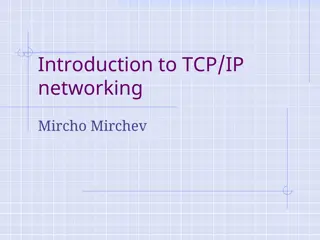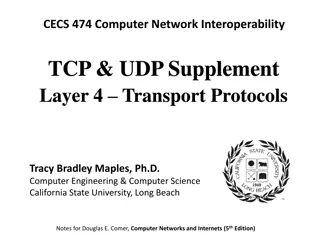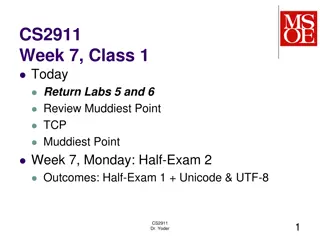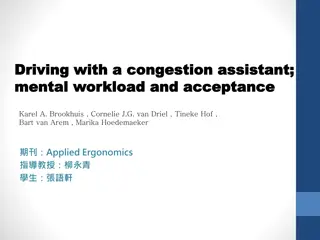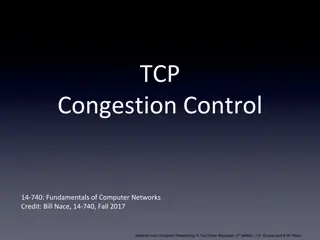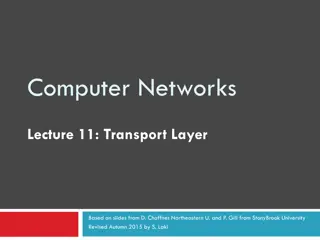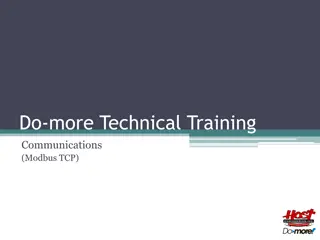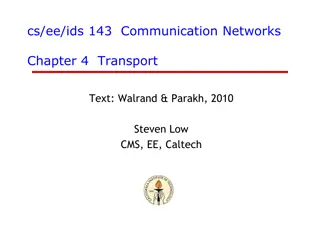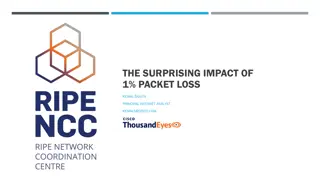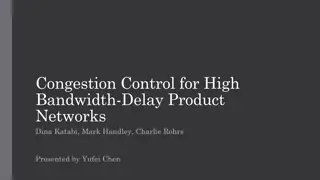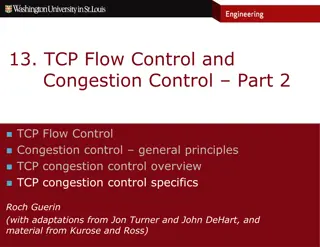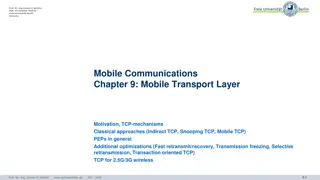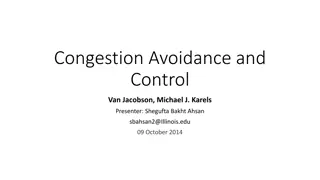Understanding TCP Congestion Control in Operating Systems
TCP congestion control is crucial for maintaining stability and efficient data transmission in computer networks. This article delves into the history and development of congestion control algorithms, highlighting key components such as additive-increase, multiplicative-decrease, and slow-start reactions. Various TCP congestion control algorithms are explored, including TCP Westwood, TCP Cubic, TCP Reno, and more. By incorporating these algorithms, network performance can be optimized by regulating the sending rate based on the perceived network congestion.
- TCP Congestion Control
- Operating Systems
- Network Performance
- Congestion Control Algorithms
- Data Communication
Download Presentation

Please find below an Image/Link to download the presentation.
The content on the website is provided AS IS for your information and personal use only. It may not be sold, licensed, or shared on other websites without obtaining consent from the author. Download presentation by click this link. If you encounter any issues during the download, it is possible that the publisher has removed the file from their server.
E N D
Presentation Transcript
IN2140: Introduction to Operating Systems and Data Communication Transport layer Congestion Control in TCP
Global congestion collapse Craig Partridge, Research Director for the Internet Research Department at BBN Technologies: Bits of the network would fade in and out, but usually only for TCP. You could ping. You could get a UDP packet through. Telnet and FTP would fail after a while. And it depended on where you were going (some hosts were just fine, others flaky) and time of day (I did a lot of work on weekends in the late 1980s and the network was wonderfully free then). Around 1pm was bad (I was on the East Coast of the US and you could tell when those pesky folks on the West Coast decided to start work...). Another experience was that things broke in unexpected ways - we spent a lot of time making sure applications were bullet-proof against failures. (..) Finally, I remember being startled when Van Jacobson first described how truly awful network performance was in parts of the Berkeley campus. It was far worse than I was generally seeing. In some sense, I felt we were lucky that the really bad stuff hit just where Van was there to see it. University of Oslo IN2140 Introduction to operating systems and data communication
Internet congestioncontrol: history around 1986: first congestion collapse 1988: "Congestion Avoidance and Control" (Jacobson) Combined congestion/flow control for TCP (also: variation change to RTO calculation algorithm) Idea: packet loss = congestion, so throttle the rate; increase otherwise Goal: stability - in equilibrum, no packet is sent into the network until an old packet leaves ack clocking, conservation of packets principle made possible through window based stop+go - behaviour Superposition of stable systems = stable network based on TCP with congestion control = stable University of Oslo IN2140 Introduction to operating systems and data communication
TCP Congestion Control TCP limits sending rate as a function of perceived network congestion little traffic increase sending rate much traffic reduce sending rate Congestion algorithm has three major components : additive-increase, multiplicative-decrease (AIMD) slow-start reaction to timeout events University of Oslo IN2140 Introduction to operating systems and data communication
TCP Congestion Control Algorithms TCP Westwood+ TCP BIC TCP Westwood TCP Cubic TCP New Reno Compound TCP the original TCP had no congestion control TCP Vegas TCP PRR TCP Reno TCP BBR TCP TCP Tahoe TCP Prague 0 1 2 3 4 5 6 7 8 9 0 1 2 3 4 5 6 7 8 9 0 1 2 3 4 5 6 7 8 9 0 1 2 3 4 5 6 7 8 9 0 1 2 3 4 5 6 7 8 9 197x 198x 199x 200x 201x University of Oslo IN2140 Introduction to operating systems and data communication
TCP Congestion Control Basic terms: congestion window (cwnd) largest amount of data (of a connection) that can be in the network at a time Testing for available bandwidth Ideally: send as fast as possible (cwnd as large as possible) without loss Increase cwnd until you have loss If loss, reduce cwnd, try increasing again maximum segment size [MSS] largest number of bytes that a TCP entity sends at once always in IPv6 and usually in IPv4: largest payload that fits into an IP packet behind the TCP header TCP header size is minimal 20 bytes with options maximal 60 bytes University of Oslo IN2140 Introduction to operating systems and data communication
TCP Congestion Control End-to-end control (no support from the network layer) Send rate is limited by the size of a congestion window, cwnd (counted in bytes) sendable, not sent yet already ack d not sendable yet sent, not ack d yet cwnd cwndbytes can be sent in each RTT: ??????? ???? =???? ??? very often the permitted bytes are sent in???? ??? packets University of Oslo IN2140 Introduction to operating systems and data communication
TCP Congestion Control sender receiver Initially, cwnd size is a few MSS in this example: 1 MSS round 1 Then, the size increases by 1 for each received ACK (until threshold ssthresh is reached or an ACK is missing) sent packets per round (cwnd) round 2 16 round 3 8 4 round 4 2 1 time University of Oslo IN2140 Introduction to operating systems and data communication
TCP Congestion Control Historically, initial ssthreshwas 65 K, now in Linux it starts with Losing a packet (TCP Tahoe): ssthresh drops to halfcwnd cwnd back to 1 Losing a single packet (TCP Reno): ssthresh drops to halfcwnd cwnd back to new threshold sent packets per round (cwnd) 80 75 70 ssthresh 65 16 60 50% 55 50 45 40 35 ssthresh 8 30 25 20 4 15 2 1 5 10 time University of Oslo IN2140 Introduction to operating systems and data communication
TCP Congestion Control Slow Start TCP will always return to a slow start when a packet loss is detected by timeout (instead of duplicate ACKs). That means that it starts from scratch with only one segment per RTT, then 2, then 4, etc. sent packets per round (congestion window) 80 75 Congestion avoidance phase 70 ssthresh 65 60 Slow-start phase 55 50 45 40 35 ssthresh Additive Increase One more segments sent after 1 RTT without loss in congestion avoidance phase 30 25 20 Todaysmallest cong. windowcan be as bigas 10 (thanksto Google) 15 Multiplicative Decrease Performed when loss is detected in slow-phase and in congestion avoidance phase 10 5 time University of Oslo IN2140 Introduction to operating systems and data communication
TCP Fairness Goal of fairness When N TCP streams share a bottleneck, each TCP stream should receive an nth of the bottleneck bandwidth more realistic demand When N TCP streams with the same RTT and loss rate share a bottleneck, and they are infinitely long, each TCP stream receives an nth of the bottleneck bandwidth but the approximation is in many cases good University of Oslo IN2140 Introduction to operating systems and data communication
TCP Congestion Control How does the AIMD algorithm achieve congestion control? interpret every packet loss as a congestion signal force TCP entities to slow down when loss is experienced available bandwidth throughput of stream 2 same share of bandwidth stream 1 has experienced loss backs off, stream 2 can increase BW consumption stream 1 can increase BW consumption stream 2 is backing off consumes less than its share throughput of stream 1 University of Oslo IN2140 Introduction to operating systems and data communication




